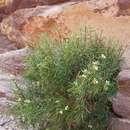Comments
provided by eFloras
A xerophytic shrub common along river banks from 800—3000 m; in trans-Indus, Hazara, Kaghan, Poonch etc. The leaves are poisonous but are tolerated by goats; can be applied for abscesses. The bark is used in diseases of bone and for washing hair. Gunpowder charcoal is said to be made from the wood. The fruit can be eaten and is used as a dye for leather.
- license
- cc-by-nc-sa-3.0
- copyright
- Missouri Botanical Garden, 4344 Shaw Boulevard, St. Louis, MO, 63110 USA
Description
provided by eFloras
Shrubs up to 2.5 m tall. Younger branches often tomentose. Leaves alternate or scattered, 3-5.8 cm long, 0.4-1 cm broad, elliptic-oblong to lanceolate, mucronate, less often obtuse, coriaceous, sessile. Flowers white, in axillary or terminal clusters, subsessile. Corolla tube 6-8 mm long, tomentose, dilated at the base, 4-lobed; lobes ovate to obovate, c. 4 mm long, spreading. Stamens 8, 2-seriate, upper 4 antisepalous, subsessile. Ovary ovoid, c. 2.5 mm long, pubescent. Style absent; stigma capitate. Berry subglobose, c. 10 mm long, pubescent, orange.
- license
- cc-by-nc-sa-3.0
- copyright
- Missouri Botanical Garden, 4344 Shaw Boulevard, St. Louis, MO, 63110 USA
Distribution
provided by eFloras
Distribution: From Garhwal westward to Murree, 1-3000 m alt. s.m.; Afghanistan, W. Pakistan, Iran, N. Africa and S. Europe.
- license
- cc-by-nc-sa-3.0
- copyright
- Missouri Botanical Garden, 4344 Shaw Boulevard, St. Louis, MO, 63110 USA
Flower/Fruit
provided by eFloras
Fl. Per. April-September.
- license
- cc-by-nc-sa-3.0
- copyright
- Missouri Botanical Garden, 4344 Shaw Boulevard, St. Louis, MO, 63110 USA
Daphne mucronata: Brief Summary
provided by wikipedia EN
Daphne mucronata is a shrub, of the family Thymelaeaceae. It is native to western Asia, ranging from eastern Turkey to the Arabian Peninsula, Iran, Afghanistan, Pakistan, and the western Himalayas.
- license
- cc-by-sa-3.0
- copyright
- Wikipedia authors and editors

